Table of Contents
What is a Cold Water Fish and What Are the Benefits of Keeping It as a Pet?
Cold water fish refer to fish species that are able to survive and thrive in water temperatures that are below the average room temperature. These fish are typically found in freshwater environments and are known for their hardy nature, making them a popular choice among aquarium hobbyists.
Keeping cold water fish as a pet has many benefits. One of the main benefits is that they are easy to care for. Unlike tropical fish, which require specific water temperatures and conditions, cold water fish are able to adapt to a wide range of water conditions. This means that they are less sensitive to changes in water temperature and pH levels, making them less prone to stress and disease.
Another benefit of keeping cold water fish is that they are relatively inexpensive. Many cold water fish species are readily available and inexpensive to purchase, making them a great option for those on a budget. Additionally, since they do not require special equipment or heating, the cost of setting up and maintaining a cold water aquarium is typically lower than that of a tropical aquarium.
Cold water fish also make great pets for children, as they are easy to care for and can be an excellent educational tool. They can help children learn about the natural world and the importance of taking care of living creatures.
Furthermore, cold water fish can be a great addition to any home, as they are visually appealing and can help to create a relaxing and peaceful environment. They can be kept in a variety of tank sizes, from small bowls to large aquariums, making them a great option for people with limited space.
Overall, cold water fish are a great choice for those looking for a low-maintenance, visually appealing, and budget-friendly pet. With proper care and maintenance, they can thrive in a home aquarium and provide hours of enjoyment for their owners.
What Equipment Do You Need for Setting Up a Cold Water Tank?
Setting up a cold water tank requires some basic equipment to ensure that your fish have a healthy and comfortable environment. The following is a list of equipment that you will need to set up a cold water tank:
- Aquarium: The first and most important piece of equipment you will need is an aquarium. The size of the aquarium will depend on the number and size of fish you plan to keep. A general rule of thumb is to provide at least 2-3 gallons of water per inch of fish.
- Tank stand: A sturdy stand or cabinet to support the weight of the aquarium is essential, especially if you plan to keep a larger tank.
- Aquarium heater: Cold water fish are able to tolerate a wide range of water temperatures, but it is still important to have a heater to keep the water at a consistent temperature. The heater should be rated for the size of your tank.
- Thermometer: A thermometer is an essential piece of equipment for monitoring the water temperature in your tank.
- Filter: A good filter is essential for keeping the water in your tank clean and clear. There are different types of filters available, including hang-on-back filters, canister filters, and undergravel filters.
- Lighting: Proper lighting is necessary for the health and well-being of your fish, as well as for viewing pleasure. You can choose between fluorescent or LED lights.
- Substrate: The bottom of your tank should be covered with a substrate, such as gravel or sand. This will not only provide a natural look but also beneficial bacteria that help to maintain the water quality
- Decorations: Decorations, such as rocks, plants, and ornaments, can be added to the tank to provide hiding places for your fish and to create a natural-looking environment.
- Water Conditioner: Using a water conditioner is essential to neutralize chlorine and chloramines from tap water, which can harm fish.
- Test Kit: A test kit is important for monitoring the water chemistry of your tank, including pH, nitrite, nitrate, and ammonia levels.
It’s important to note that the above list is not exhaustive and you may need additional equipment for specific fish species, for example, a chiller for sensitive species that require a lower temperature. It’s always best to research the specific needs of the fish you plan to keep before setting up the tank.
What Do Cold-Water Fishes Eat and How Often?
Cold water fish are omnivorous, which means they will eat a variety of different foods. The diet of cold water fish can include a combination of live, frozen, and dried food. The specific diet requirements will vary depending on the species of fish, but most cold water fish will eat a variety of different types of food.
Live food: Live food, such as brine shrimp, daphnia, and bloodworms, is a great option for cold water fish. These foods provide a natural diet and are high in protein. They also offer a hunting and feeding experience which is natural for the fish.
Frozen food: Frozen foods, such as krill, plankton, and mysis shrimp, are a convenient option for cold water fish. These foods are flash-frozen to preserve their nutritional value and can be stored for long periods of time in the freezer.
Dried food: Dried foods, such as flakes and pellets, are a convenient option for cold water fish. They are easy to store and are available in a variety of different formulations, including those specifically formulated for cold water fish.
It’s important to note that different species of cold water fish may have specific dietary needs, so it’s always best to research the specific dietary requirements of the fish you plan to keep.
In terms of feeding schedule, most cold water fish should be fed small amounts of food 2-3 times a day. It’s important to avoid overfeeding, as this can lead to poor water quality and health problems for the fish. A general rule of thumb is to only feed what the fish can consume in 2-3 minutes. It’s also important to monitor the fish to make sure they are eating and to adjust the feeding schedule as necessary.
In addition, providing a varied diet is important for the overall health and well-being of cold water fish. Offering a variety of different types of food will ensure that the fish are getting all of the necessary nutrients and will also keep them interested in their food.
Cold Water Fish For Beginners
The following are the list of 30+ Cold Water Fish suitable for beginner aquariums, please note this is only a small list and there are many fish out there which are suitable for Aquariums and biggest advantage is most of them don’t need a heater and survive in room temperature as long as you maintain proper water quality, timely feeding and select the right fish to be tankmates.
Goldfish
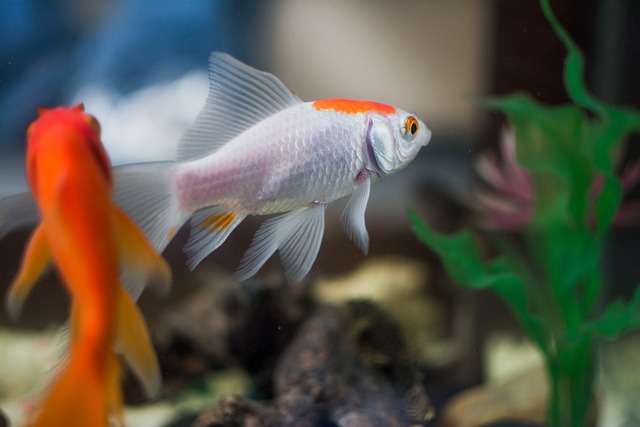
Goldfish (Carassius auratus) are a popular cold water fish species that are commonly kept in home aquariums. They are a domesticated form of the wild Prussian carp, and have been kept as ornamental fish for over a thousand years. They come in a variety of colors, including gold, orange, white, and black. They are also available in different body shapes, such as comet, fantail, and oranda.
Goldfish have a characteristic elongated body shape, with a dorsal fin and a pair of anal fins located at the back of the fish. They have a pair of fins at the front of their body, which are used for steering and balance. They also have a pair of pectoral fins located near their head, which are used for propulsion. They have a single caudal fin at the end of their body, which is used for propulsion. They can grow up to 40 cm (16 inches) in length and can weigh up to 1.3 kg (3 lbs).
Goldfish are relatively hardy fish that are easy to care for. They require a minimum tank size of 20 gallons for a single goldfish and 40 gallons for two or more. They require a pH level between 7-8 and a temperature range between 18-24°C (65-75°F). They also require a high-quality filtration system to keep the water clean and well-oxygenated. They are also relatively hardy fish that can adapt to a variety of water conditions. They should be fed a varied diet of both commercial fish food and live or frozen food. It’s important to note that goldfish produce a large amount of waste, so regular water changes are necessary to maintain good water quality.
In summary, Goldfish are one of the most popular cold water fish species that are commonly kept in home aquariums. They come in a variety of colors and body shapes, and are relatively hardy fish that are easy to care for. They require a minimum tank size of 20 gallons and a pH level between 7-8 and a temperature range between 18-24°C (65-75°F). They are also a relatively hardy fish that can adapt to a variety of water conditions, and require a high-quality filtration system to keep the water clean and well-oxygenated. They should be fed a varied diet of both commercial fish food and live or frozen food. It’s important to note that goldfish produce a large amount of waste, so regular water changes are necessary to maintain good water quality.
Bettas
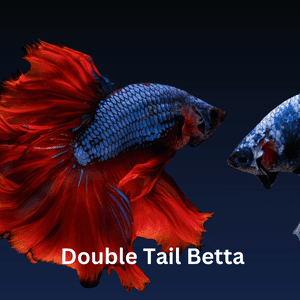
Bettas, also known as Siamese Fighting Fish, are a popular cold water fish species that are commonly kept in home aquariums. They are native to the rice paddies and canals of Southeast Asia, and are known for their vibrant colors and beautiful fins. They come in a variety of colors, including red, blue, green, and purple. They are also available in different tail types, such as half-moon, crowntail, and veil tail.
Bettas have a characteristic elongated body shape, with a single dorsal fin located at the back of the fish. They have a pair of fins at the front of their body, which are used for steering and balance. They also have a pair of pectoral fins located near their head, which are used for propulsion. They have a single caudal fin at the end of their body, which is used for propulsion. They can grow up to 7 cm (3 inches) in length and can weigh up to 0.1 kg (0.2 lbs).
Bettas are relatively hardy fish that are easy to care for. They require a minimum tank size of 2 gallons for a single betta and 5 gallons for a pair. They require a pH level between 6.5-7.5 and a temperature range between 24-28°C (75- 82°F). Bettas are also known for their territorial behavior and should not be housed with other male Bettas or other aggressive fish species. They also require a high-quality filtration system to keep the water clean and well-oxygenated. Bettas should be fed a varied diet of both commercial fish food and live or frozen food. It’s important to note that Bettas are sensitive to water conditions and changes, so it is important to acclimate them slowly to any new tank or water.
Bettas are a very popular fish species, and there are many images and videos available online that showcase their unique characteristics and beauty. Some popular online platforms for viewing images and videos of Bettas include aquarium websites, fish-keeping forums, and social media groups dedicated to the hobby. These resources can be a great way to learn more about Bettas and get inspiration for your own aquarium setup.
In summary, Bettas are a popular cold water fish species that are commonly kept in home aquariums. They are known for their vibrant colors and beautiful fins, and come in a variety of colors and tail types. They are relatively hardy fish that are easy to care for. They require a minimum tank size of 2 gallons for a single Betta and 5 gallons for a pair. They require a pH level between 6.5-7.5 and a temperature range between 24-28°C (75-82°F). They are also known for their territorial behavior and should not be housed with other male Bettas or other aggressive fish species. They also require a high-quality filtration system to keep the water clean and well-oxygenated. Bettas should be fed a varied diet of both commercial fish food and live or frozen food. They are sensitive to water conditions and changes, so it is important to acclimate them slowly to any new tank or water.
Guppies
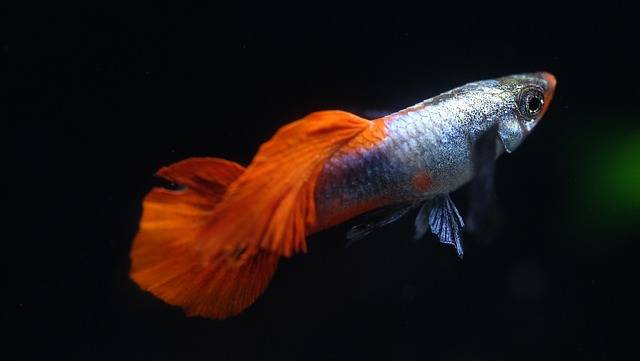
Guppies, also known as millionfish, are a popular cold water fish species that are commonly kept in home aquariums. They are native to South America and the Caribbean and are known for their bright colors and hardiness. They come in a variety of colors, including red, blue, green, and yellow. They are also available in different tail types, such as lyretail and fan tail.
Guppies have a characteristic elongated body shape, with a single dorsal fin located at the back of the fish. They have a pair of fins at the front of their body, which are used for steering and balance. They also have a pair of pectoral fins located near their head, which are used for propulsion. They have a single caudal fin at the end of their body, which is used for propulsion. They can grow up to 5 cm (2 inches) in length and can weigh up to 0.05 kg (0.1 lbs).
Guppies are relatively hardy fish that are easy to care for. They require a minimum tank size of 10 gallons for a small group of guppies. They require a pH level between 7-8 and a temperature range between 18-28°C (65-82°F). They are also known for their adaptability and can tolerate a wide range of water conditions. They also require a high-quality filtration system to keep the water clean and well-oxygenated. Guppies should be fed a varied diet of both commercial fish food and live or frozen food. It’s important to note that guppies are livebearers and will breed readily in captivity.
In summary, Guppies are a popular cold water fish species that are commonly kept in home aquariums. They are known for their bright colors and hardiness, and come in a variety of colors and tail types. They are relatively hardy fish that are easy to care for. They require a minimum tank size of 10 gallons for a small group of guppies. They require a pH level between 7-8 and a temperature range between 18-28°C (65-82°F). They are also known for their adaptability and can tolerate a wide range of water conditions. They also require a high-quality filtration system to keep the water clean and well-oxygenated. Guppies should be fed a varied diet of both commercial fish food and live or frozen food. They are livebearers and will breed readily in captivity. It’s important to note that excessive breeding can lead to overpopulation and poor water quality, so it’s important to monitor the population and consider separating males and females or removing some fry if necessary.
Neon Tetras

Neon Tetras, also known as Paracheirodon innesi, are a popular cold water fish species that are commonly kept in home aquariums. They are native to South America and are known for their bright colors and small size. They come in a vibrant neon blue and red coloration and are a favorite among aquarists for their lively appearance.
Neon Tetras have a small, elongated body shape, with a single dorsal fin located at the back of the fish. They have a pair of fins at the front of their body, which are used for steering and balance. They also have a pair of pectoral fins located near their head, which are used for propulsion. They have a single caudal fin at the end of their body, which is used for propulsion. They can grow up to 2.5 cm (1 inch) in length and can weigh up to 0.02 kg (0.04 lbs).
Neon Tetras are relatively hardy fish that are easy to care for but require a specific tank set up. They require a minimum tank size of 20 gallons for a small group of neon tetras. They require a pH level between 5.5-7 and a temperature range between 22-26°C (72-79°F). They also require a high-quality filtration system to keep the water clean and well-oxygenated. Neon Tetras should be fed a varied diet of both commercial fish food and live or frozen food. It’s important to note that neon tetras are shoaling fish and do best when kept in groups, at least 6 or more. Also, they prefer dim lighting and planted tanks.
In summary, Neon Tetras are a popular cold water fish species that are commonly kept in home aquariums. They are known for their bright neon blue and red coloration and small size. They are relatively hardy fish that are easy to care for but require a specific tank set up,
Zebra Danios

Zebra Danios, also known as Danio rerio, are a popular cold water fish species that are commonly kept in home aquariums. They are native to South Asia and are known for their active and energetic behavior, hardiness, and distinctive zebra-like stripes. They come in various color morphs such as the wild, golden, leopard and long finned.
Zebra Danios have a small, elongated body shape, with a single dorsal fin located at the back of the fish. They have a pair of fins at the front of their body, which are used for steering and balance. They also have a pair of pectoral fins located near their head, which are used for propulsion. They have a single caudal fin at the end of their body, which is used for propulsion. They can grow up to 7 cm (2.8 inches) in length and can weigh up to 0.03 kg (0.06 lbs).
Zebra Danios are hardy fish that are easy to care for. They require a minimum tank size of 10 gallons for a small group of Zebra Danios. They require a pH level between 6.5-7.5 and a temperature range between 20-26°C (68-79°F). They also require a high-quality filtration system to keep the water clean and well-oxygenated. Zebra Danios should be fed a varied diet of both commercial fish food and live or frozen food. They are also known for their hardiness and adaptability to different water conditions which make them a great addition for beginner fishkeepers. They are also known to be schooling fish and should be kept in groups of at least 5 or more.
Zebra Danios are hardy fish, but they are also prone to certain health issues if not cared for properly. Some tips to keep Zebra Danios healthy include maintaining the proper water temperature, pH, and water quality through regular water changes and cleaning of the tank and equipment. It’s also important to feed them a varied diet and to not overfeed them. It’s also important to provide them with enough swimming space and to keep them in a group as they are social fish.
In summary, Zebra Danios are a popular cold water fish species that are commonly kept in home aquariums. They are known for their active and energetic behavior, hardiness, and distinctive zebra-like stripes. They are relatively hardy fish that are easy to care for and can adapt to different water conditions which makes them a great addition for beginner fishkeepers. They are also known to be schooling fish and should be kept in groups of at least 5 or more. With proper care and tank setup, Zebra Danios can thrive and make a beautiful addition to any cold water aquarium.
White Cloud Mountain Minnows
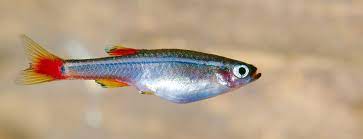
White Cloud Mountain Minnows, also known as Tanichthys albonubes, are a popular cold water fish species that are commonly kept in home aquariums. They are native to the White Cloud Mountain region of China and are known for their hardiness, small size, and vibrant colors. They are known to be peaceful and easy to care for, making them a great option for beginner fishkeepers.
White Cloud Mountain Minnows have a small, elongated body shape, with a single dorsal fin located at the back of the fish. They have a pair of fins at the front of their body, which are used for steering and balance. They also have a pair of pectoral fins located near their head, which are used for propulsion. They have a single caudal fin at the end of their body, which is used for propulsion. They can grow up to 4 cm (1.5 inches) in length and can weigh up to 0.02 kg (0.04 lbs). They are known for their bright silver and red colors, with males having a more vibrant red coloration.
White Cloud Mountain Minnows are hardy fish that are easy to care for. They require a minimum tank size of 10 gallons for a small group of White Cloud Mountain Minnows. They require a pH level between 6.5-7.5 and a temperature range between 12-22°C (53-71°F). They also require a high-quality filtration system to keep the water clean and well-oxygenated. White Cloud Mountain Minnows should be fed a varied diet of both commercial fish food and live or frozen food. They are also known to be a peaceful fish and can be kept with other peaceful fish species such as Neon Tetras and Guppies.
White Cloud Mountain Minnows are a very popular fish species, and there are many images and videos available online that showcase their unique characteristics and behavior. Some popular online platforms for viewing images and videos of White Cloud Mountain Minnows include aquarium websites, fish-keeping forums, and social media groups dedicated to the hobby. These resources can be a great way to learn more about White Cloud Mountain Minnows and get inspiration for your own aquarium setup.
White Cloud Mountain Minnows are hardy fish, but they are also prone to certain health issues if not cared for properly. Some tips to keep White Cloud Mountain Minnows healthy include maintaining the proper water temperature, pH, and water quality through regular water changes and cleaning of the tank and equipment. It’s also important to feed them a varied diet and to not overfeed them. It’s also important to provide them with enough swimming space and to keep them in a peaceful environment.
In summary, White Cloud Mountain Minnows are a popular cold water fish species that are commonly kept in home aquariums. They are known for their hardiness, small size, and vibrant colors. They are relatively hardy fish that are easy to care for and can adapt to different water conditions which makes them a great addition for beginner fishkeepers. With proper care and tank setup, White Cloud Mountain Minnows can thrive and make a beautiful addition to any cold water aquarium.
Cherry Barbs
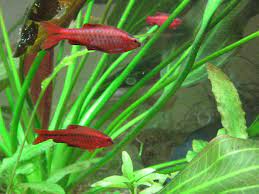
Cherry Barbs, also known as Puntius titteya, are a popular cold water fish species that are commonly kept in home aquariums. They are native to Sri Lanka and are known for their hardiness, small size, and vibrant colors. They are known to be peaceful and easy to care for, making them a great option for beginner fishkeepers.
Cherry Barbs have a small, elongated body shape, with a single dorsal fin located at the back of the fish. They have a pair of fins at the front of their body, which are used for steering and balance. They also have a pair of pectoral fins located near their head, which are used for propulsion. They have a single caudal fin at the end of their body, which is used for propulsion. They can grow up to 4 cm (1.5 inches) in length and can weigh up to 0.02 kg (0.04 lbs). They are known for their bright red coloration, which gives them their name. The males have a more vibrant red coloration compared to females.
Cherry Barbs are hardy fish that are easy to care for. They require a minimum tank size of 10 gallons for a small group of Cherry Barbs. They require a pH level between 6.5-7.5 and a temperature range between 18-24°C (64-75°F). They also require a high-quality filtration system to keep the water clean and well-oxygenated. Cherry Barbs should be fed a varied diet of both commercial fish food and live or frozen food. They are also known to be a peaceful fish and can be kept with other peaceful fish species such as Neon Tetras and Guppies.
Cherry Barbs are a very popular fish species, and there are many images and videos available online that showcase their unique characteristics and behavior. Some popular online platforms for viewing images and videos of Cherry Barbs include aquarium websites, fish-keeping forums, and social media groups dedicated to the hobby. These resources can be a great way to learn more about Cherry Barbs and get inspiration for your own aquarium setup.
Cherry Barbs are hardy fish, but they are also prone to certain health issues if not cared for properly. Some tips to keep Cherry Barbs healthy include maintaining the proper water temperature, pH, and water quality through regular water changes and cleaning of the tank and equipment. It’s also important to feed them a varied diet
Platies
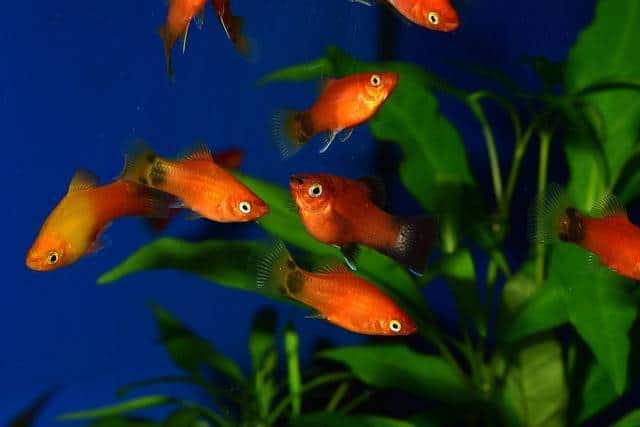
Platies, also known as Xiphophorus maculatus, are a popular cold water fish species that are commonly kept in home aquariums. They are native to Central America and are known for their hardiness, small size, and vibrant colors. They are known to be peaceful and easy to care for, making them a great option for beginner fishkeepers.
Platies have a small, elongated body shape, with a single dorsal fin located at the back of the fish. They have a pair of fins at the front of their body, which are used for steering and balance. They also have a pair of pectoral fins located near their head, which are used for propulsion. They have a single caudal fin at the end of their body, which is used for propulsion. They can grow up to 6 cm (2.5 inches) in length and can weigh up to 0.02 kg (0.04 lbs). They are known for their vibrant coloration, which can be red, orange, yellow, green, and blue.
Platies are hardy fish that are easy to care for. They require a minimum tank size of 10 gallons for a small group of Platies. They require a pH level between 7.0-8.0 and a temperature range between 22-26°C (72-78°F). They also require a high-quality filtration system to keep the water clean and well-oxygenated. Platies should be fed a varied diet of both commercial fish food and live or frozen food. They are also known to be a peaceful fish and can be kept with other peaceful fish species such as Neon Tetras and Guppies.
Swordtails
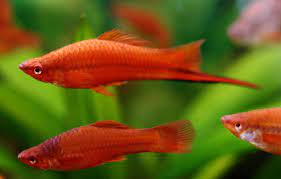
Swordtails, also known as Xiphophorus hellerii, are a popular cold water fish species that are commonly kept in home aquariums. They are native to Central America and are known for their hardiness, small size, and vibrant colors. They are known to be peaceful and easy to care for, making them a great option for beginner fishkeepers.
Swordtails have a small, elongated body shape, with a single dorsal fin located at the back of the fish. They have a pair of fins at the front of their body, which are used for steering and balance. They also have a pair of pectoral fins located near their head, which are used for propulsion. They have a single caudal fin at the end of their body, which is used for propulsion. They can grow up to 8 cm (3 inches) in length and can weigh up to 0.02 kg (0.04 lbs). They are known for their vibrant coloration, which can be red, orange, yellow, green, and blue. They also have a long, sword-like extension on their caudal fin, which gives them their name.
Swordtails are hardy fish that are easy to care for. They require a minimum tank size of 20 gallons for a small group of Swordtails. They require a pH level between 7.0-8.0 and a temperature range between 22-26°C (72-78°F). They also require a high-quality filtration system to keep the water clean and well-oxygenated. Swordtails should be fed a varied diet of both commercial fish food and live or frozen food. They are also known to be a peaceful fish and can be kept with other peaceful fish species such as Neon Tetras, Guppies, and Platies. It is important to note that Swordtails are livebearers, which means they give birth to live young instead of laying eggs. This means that they can breed easily in the home aquarium and it is important to keep an eye on population numbers to prevent overstocking.
Mollies
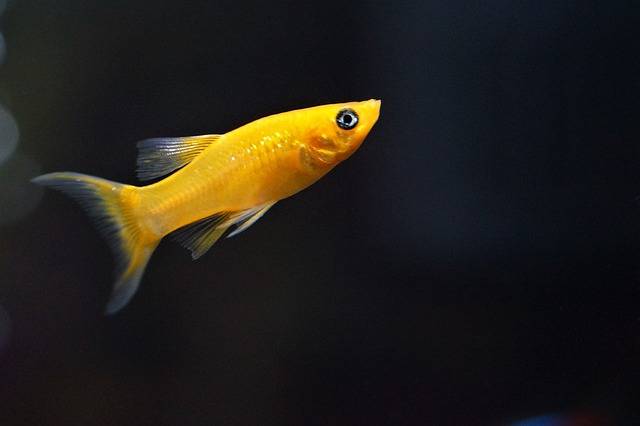
Mollies, also known as Poecilia sphenops, are a popular cold water fish species that are They are native to Central America and are known for their hardiness, small size, and vibrant colors. They are known to be peaceful and easy to care for, making them a great option for beginner fishkeepers.
Mollies have a small, elongated body shape, with a single dorsal fin located at the back of the fish. They have a pair of fins at the front of their body, which are used for steering and balance. They also have a pair of pectoral fins located near their head, which are used for propulsion. They have a single caudal fin at the end of their body, which is used for propulsion. They can grow up to 8 cm (3 inches) in length and can weigh up to 0.02 kg (0.04 lbs). They are known for their vibrant coloration, which can be black, silver, orange, yellow, green, and blue. They also have a long, sword-like extension on their dorsal fin, which gives them their name.
Mollies are hardy fish that are easy to care for. They require a minimum tank size of 20 gallons for a small group of Mollies. They require a pH level between 7.0-8.0 and a temperature range between 22-26°C (72-78°F). They also require a high-quality filtration system to keep the water clean and well-oxygenated. Mollies should be fed a varied diet of both commercial fish food and live or frozen food. They are also known to be a peaceful fish and can be kept with other peaceful fish species such as Neon Tetras, Guppies, Platies, and Swordtails. It is important to note that Mollies are livebearers, which means they give birth to live young instead of laying eggs. This means that they can breed easily in the home aquarium and it is important to keep an eye on population numbers to prevent overstocking.
Corydoras Catfish

Corydoras Catfish, also known as Corydoras sp, are a popular cold water fish species that are commonly kept in home aquariums. They are native to South America and are known for their hardiness, small size, and peaceful nature. They are known to be easy to care for, making them a great option for beginner fishkeepers.
Corydoras Catfish have a small, elongated body shape, with a single dorsal fin located at the back of the fish. They have a pair of fins at the front of their body, which are used for steering and balance. They also have a pair of pectoral fins located near their head, which are used for propulsion. They have a single caudal fin at the end of their body, which is used for propulsion. They can grow up to 6 cm (2.5 inches) in length and can weigh up to 0.02 kg (0.04 lbs). They are known for their varying coloration, which can be brown, black, green, or even albino. They also have a distinct pattern of stripes or spots on their body which helps to camouflage them in their natural habitat.
Corydoras Catfish are hardy fish that are easy to care for. They require a minimum tank size of 20 gallons for a small group of Corydoras Catfish. They require a pH level between 6.5-7.5 and a temperature range between 22-26°C (72-78°F). They also require a high-quality filtration system to keep the water clean and well-oxygenated. Corydoras Catfish should be fed a varied diet of both commercial fish food and live or frozen food. They are also known to be a peaceful fish and can be kept with other peaceful fish species such as Neon Tetras, Guppies, Platies, Swordtails, and Mollies. They also appreciate having a sandy substrate in the tank and hiding spots such as caves or PVC pipes.
Kuhli Loaches

Kuhli Loaches, also known as Pangio kuhlii, are a popular cold water fish species that are commonly kept in home aquariums. They are native to Southeast Asia and are known for their unique appearance, small size, and peaceful nature. They are known to be easy to care for, making them a great option for beginner fishkeepers.
Kuhli Loaches have a small, elongated, and eel-like body shape. They have a pair of fins at the front of their body, which are used for steering and balance. They also have a pair of pectoral fins located near their head, which are used for propulsion. They have a single caudal fin at the end of their body, which is used for propulsion. They can grow up to 10 cm (4 inches) in length and can weigh up to 0.02 kg (0.04 lbs). They are known for their unique appearance, with a slender body that is almost translucent, and they have a series of dark bands that run along their body.
Kuhli Loaches are hardy fish that are easy to care for. They require a minimum tank size of 20 gallons for a small group of Kuhli Loaches. They require a pH level between 6.5-7.5 and a temperature range between 22-26°C (72-78°F). They also require a high-quality filtration system to keep the water clean and well-oxygenated. Kuhli Loaches should be fed a varied diet of both commercial fish food and live or frozen food. They also appreciate having a sandy substrate in the tank and hiding spots such as caves or PVC pipes. They are also known to be a peaceful fish and can be kept with other peaceful fish species such as Neon Tetras, Guppies, Platies, Swordtails, Mollies and Corydoras Catfish.
Mystery Snails

Mystery Snails, also known as Pomacea bridgesii, are freshwater snails that are commonly kept in home aquariums. They are native to South America and are known for their unique appearance, small size, and peaceful nature. They are known to be easy to care for, making them a great option for beginner fishkeepers.
Mystery Snails have a large, round body shape with a distinct spiral shell. They can grow up to 5 cm (2 inches) in diameter and can weigh up to 0.05 kg (0.11 lbs). They come in a variety of colors including brown, black, blue, and gold. They have a single pair of tentacles on their head, which they use to navigate and find food. They also have a small foot that they use to move around the tank.
Mystery Snails are hardy creatures that are easy to care for. They require a minimum tank size of 10 gallons for a small group of Mystery Snails. They require a pH level between 6.5-7.5 and a temperature range between 22-26°C (72-78°F). They also require a high-quality filtration system to keep the water clean and well-oxygenated. Mystery Snails should be fed a varied diet of both commercial fish food and live or frozen food. They also appreciate having a sandy substrate in the tank and hiding spots such as caves or PVC pipes. They are also known to be peaceful creatures and can be kept with other peaceful fish species such as Neon Tetras, Guppies, Platies, Swordtails, Mollies, Corydoras Catfish, and Kuhli Loaches.
In conclusion, there are many different types of cold water fish that are suitable for home aquariums. Each species has its own unique characteristics, physical appearance, and requirements for tank setup and care. Some popular cold water fish species include Goldfish, Guppies, Betta, Zebra Danios, White Cloud Mountain Minnows, Cherry Barbs, Platies, Swordtails, Mollies, Corydoras Catfish, Kuhli Loaches, and Mystery Snails. As a fishkeeper, it is important to research the specific needs and compatibility of each species before adding them to your tank. With proper care and maintenance, you can create a beautiful and thriving cold water aquarium that will be enjoyed for years to come.
Rosy Barbs
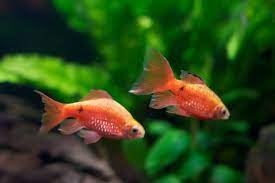
Rosy Barbs, also known as Pethia conchonius, are a popular cold water fish species that are commonly kept in home aquariums. They are native to India and Pakistan and are known for their vibrant coloration, small size, and peaceful nature. They are known to be easy to care for, making them a great option for beginner fishkeepers.
Rosy Barbs have a small, elongated, and streamlined body shape. They have a pair of fins at the front of their body, which are used for steering and balance. They also have a pair of pectoral fins located near their head, which are used for propulsion. They have a single caudal fin at the end of their body, which is used for propulsion. They can grow up to 6 cm (2.5 inches) in length and can weigh up to 0.02 kg (0.04 lbs). They are known for their vibrant coloration, with a pink or red body and a silver-white belly. The males also have a more pronounced red coloration on the fins and the body.
Rosy Barbs are hardy fish that are easy to care for. They require a minimum tank size of 20 gallons for a small group of Rosy Barbs. They require a pH level between 6.5-7.5 and a temperature range between 22-26°C (72-78°F). They also require a high-quality filtration system to keep the water clean and well-oxygenated. Rosy Barbs should be fed a varied diet of both commercial fish food and live or frozen food. They also appreciate having a sandy substrate in the tank and hiding spots such as caves or PVC pipes. They are also known to be a peaceful fish and can be kept with other peaceful fish species such as Neon Tetras, Guppies, Platies, Swordtails, Mollies, Corydoras Catfish, and Kuhli Loaches.
Rosy Barbs are also known to be schooling fish, which means that they prefer to be kept in groups of at least six individuals. Keeping them in a group will not only help them feel more comfortable, but it will also bring out their best colors and natural behaviors. They are also known to be active swimmers, so make sure to provide them with plenty of open swimming space.
In terms of breeding, Rosy Barbs are known to be easy to breed in captivity. They are egg-scatterers, which means that they will scatter their eggs among the plants or other structures in the tank. Once the eggs hatch, the fry will be free-swimming and should be fed with baby brine shrimp or other suitable foods.
In conclusion, Rosy Barbs are a great option for cold water aquariums. They are hardy, easy to care for, and have vibrant coloration. They are also known to be peaceful and can be kept with other peaceful fish species. They also require minimal tank space and can be easily bred in captivity. With proper care and maintenance, Rosy Barbs can thrive in a home aquarium and provide hours of enjoyment for their owners.
Koi
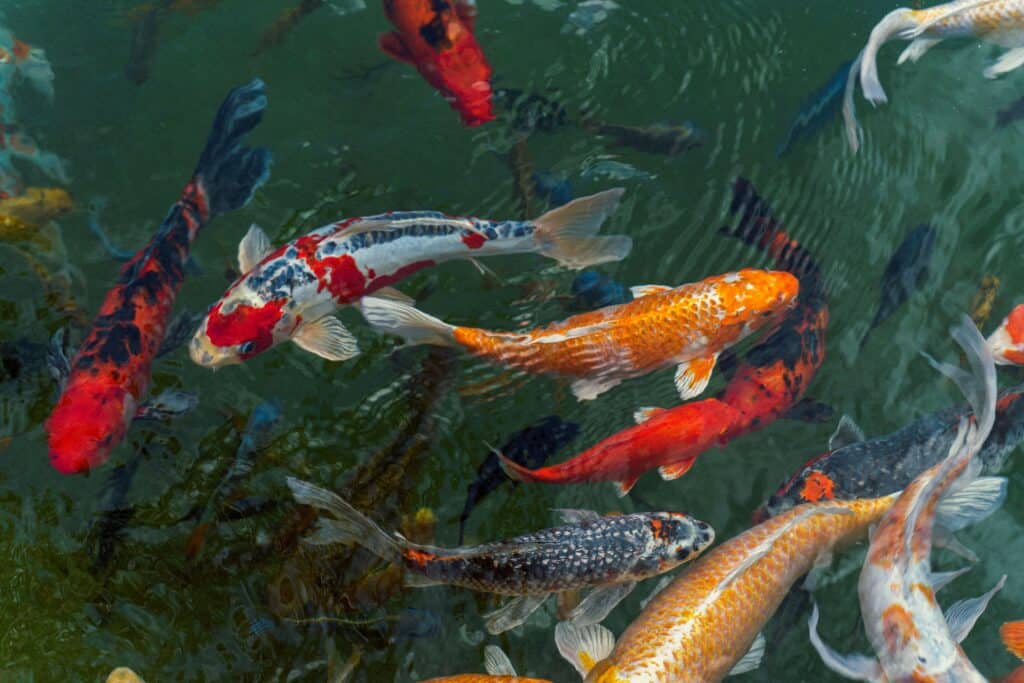
Koi, also known as Nishikigoi, are a domesticated form of the common carp that originate from Japan. They are known for their vibrant colors, patterns, and long lifespans. They have become a popular choice among fish enthusiasts and are often kept in outdoor ponds or large indoor tanks.
Koi are hardy fish that can tolerate a wide range of water temperatures, from around 40-85°F. They prefer water that is neutral to slightly alkaline, with a pH level between 7.0-8.5. They also require a high-quality filtration system to keep the water clean and clear.
Koi are omnivorous and will eat a variety of different foods, including pellets, flakes, frozen, and live foods such as brine shrimp and worms. They also enjoy eating vegetables such as peas, lettuce, and cucumber. It’s important to provide a balanced diet and to avoid overfeeding, as this can lead to health problems.
Koi are known for their vibrant colors, which come in a wide range of patterns and shades, including white, yellow, orange, red, blue, black, and even metallic. The most popular color patterns include Kohaku (white and red), Sanke (white, black and red), and Showa (black and red).
Koi can grow quite large, reaching lengths of up to 3 feet and weighing up to 50 pounds. They can live for more than 50 years in captivity, making them a long-term commitment as a pet.
Koi are also known for their calming and soothing effects and for their ability to reduce stress and improve mental well-being. They are considered to be a symbol of good luck, prosperity, and friendship in many cultures. In terms of maintenance, Koi require regular cleaning and maintenance of their ponds to ensure optimal living conditions.
Harlequin Rasboras
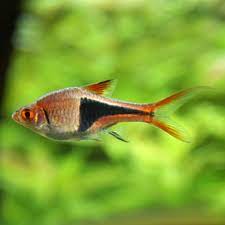
Harlequin Rasboras (Trigonostigma heteromorpha) are small, freshwater fish that are native to Southeast Asia. They are known for their vibrant colors, which are typically orange and black, giving them a distinctive harlequin pattern. They are a popular choice among fish enthusiasts and are often kept in community tanks.
Harlequin Rasboras are hardy fish that can tolerate a wide range of water temperatures, from around 72-78°F. They prefer water that is neutral to slightly acidic, with a pH level between 6.0-7.0. They also require a high-quality filtration system to keep the water clean and clear. They are best kept in a group of at least six or more in a tank of at least 20 gallons.
Harlequin Rasboras are omnivorous and will eat a variety of different foods, including pellets, flakes, frozen, and live foods such as brine shrimp and worms. They also enjoy eating vegetables such as peas, lettuce, and cucumber. It’s important to provide a balanced diet and to avoid overfeeding, as this can lead to health problems.
Harlequin Rasboras are known for their vibrant colors, which are typically orange and black, giving them a distinctive harlequin pattern. They have a slender, elongated body shape and a pointed snout. They grow to be about 1.5 inches in length.
Harlequin Rasboras grow to be about 1.5 inches in length and can live for up to 3-5 years in captivity. They are relatively small and peaceful fish, which makes them a great addition to a community tank.
Harlequin Rasboras are known to be schooling fish and should be kept in groups of at least 6 or more. They are also quite active and prefer a well-planted tank with plenty of hiding spots. They are also a great option for beginner fish keepers as they are relatively easy to care for and are hardy fish. They are also known to be a peaceful fish and can be kept with other peaceful community fish.
Dwarf Gourami
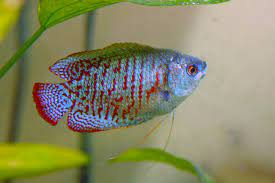
Dwarf Gourami (Colisa lalia) is a small, freshwater fish native to South Asia. They are known for their vibrant colors and are a popular choice among fish enthusiasts. They are often kept in community tanks and come in a variety of colors such as blue, powder blue, opaline, neon blue, and red.
Dwarf Gourami are relatively hardy fish, but they do require specific conditions to thrive. They prefer water temperatures between 72-82°F, with a pH level between 6.5-7.5. They also require a high-quality filtration system to keep the water clean and clear. They are best kept in a tank of at least 20 gallons, with plenty of hiding spots and plants.
Dwarf Gourami are omnivorous and will eat a variety of different foods, including pellets, flakes, frozen, and live foods such as brine shrimp, worms, and small insects. They also enjoy eating vegetables such as peas, lettuce, and cucumber. It’s important to provide a balanced diet and to avoid overfeeding, as this can lead to health problems.
Dwarf Gourami are known for their vibrant colors, which come in a variety of shades such as blue, powder blue, opaline, neon blue, and red. They have a round, oval body shape and an elongated dorsal fin. They grow to be about 2 inches in length.
Dwarf Gourami grow to be about 2 inches in length and can live for up to 3-5 years in captivity. They are relatively small and peaceful fish, which makes them a great addition to a community tank.
Dwarf Gourami are known to be relatively peaceful and can be kept with other peaceful community fish. They also have a labyrinth organ, which allows them to breathe atmospheric air, which can be helpful in poorly oxygenated water. They are also known to be a great option for beginner fish keepers as they are relatively easy to care for and are hardy fish.
Panda Corydoras
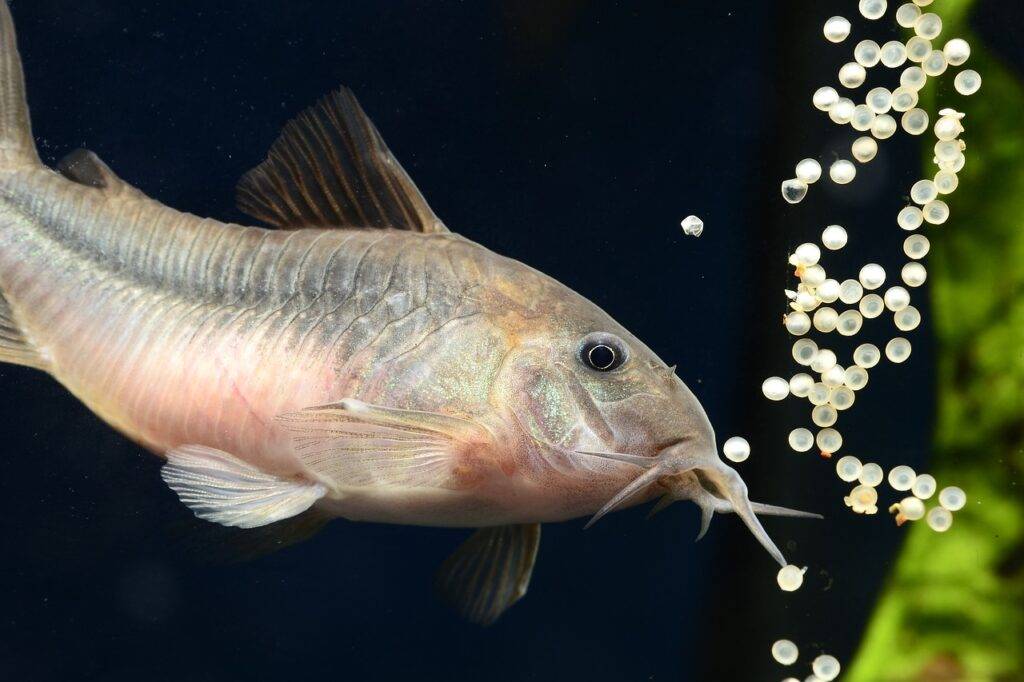
Panda Corydoras (Corydoras panda) is a freshwater fish that is native to South America. As the name suggests, these fish have a black and white pattern that looks like a Panda, which is what makes them so popular among fish enthusiasts. They are a small and peaceful fish that are often kept in community tanks.
Panda Corydoras are hardy fish, but they do require specific conditions to thrive. They prefer water temperatures between 72-78°F, with a pH level between 6.5-7.5. They also require a high-quality filtration system to keep the water clean and clear. They are best kept in a tank of at least 20 gallons, with plenty of hiding spots and plants.
Panda Corydoras are bottom-dwelling fish that are primarily carnivorous. They will eat a variety of different foods, including pellets, flakes, frozen, and live foods such as brine shrimp, worms, and small insects. They also enjoy eating vegetables such as peas, lettuce, and cucumber. It’s important to provide a balanced diet and to avoid overfeeding, as this can lead to health problems.
Panda Corydoras are known for their black and white coloration that looks like a Panda, which makes them so popular among fish enthusiasts. They have a round, oval body shape and a short dorsal fin. They grow to be about 2 inches in length.
Panda Corydoras grow to be about 2 inches in length and can live for up to 5-10 years in captivity. They are relatively small and peaceful fish, which makes them a great addition to a community tank.
Panda Corydoras are known to be relatively peaceful and can be kept with other peaceful community fish. They are also known to be a great option for beginner fish keepers as they are relatively easy to care for and are hardy fish. They are also a good option for those who are looking for a fish that is a little more unique and interesting to look at.
Black Phantom Tetra

The Black Phantom Tetra (Hyphessobrycon megalopterus) is a freshwater fish that is native to South America. As the name suggests, these fish have a black coloration on their dorsal and tail fins, which gives them a unique and striking appearance. They are a small and peaceful fish that are often kept in community tanks.
Black Phantom Tetra are hardy fish, but they do require specific conditions to thrive. They prefer water temperatures between 72-78°F, with a pH level between 6.5-7.5. They also require a high-quality filtration system to keep the water clean and clear. They are best kept in a tank of at least 20 gallons, with plenty of hiding spots and plants.
Black Phantom Tetra are carnivorous fish that will eat a variety of different foods, including pellets, flakes, frozen, and live foods such as brine shrimp, worms, and small insects. They also enjoy eating vegetables such as peas, lettuce, and cucumber. It’s important to provide a balanced diet and to avoid overfeeding, as this can lead to health problems.
Black Phantom Tetra is known for its striking black coloration on their dorsal and tail fins, which gives them a unique and attractive appearance. They have a sleek, slender body shape and a short dorsal fin. They grow to be about 2 inches in length.
Black Phantom Tetra grow to be about 2 inches in length and can live for up to 5-10 years in captivity. They are relatively small and peaceful fish, which makes them a great addition to a community tank.
Black Phantom Tetra are known to be relatively peaceful and can be kept with other peaceful community fish. They are also known to be a great option for beginner fish keepers as they are relatively easy to care for and are hardy fish. They are also a good option for those who are looking for a fish that is a little more unique and interesting to look at. Additionally, they are schooling fish and it is best to keep them in groups of at least 6 individuals to make them feel comfortable and thrive.
Glass Catfish (Kryptopterus bicirrhis)
Glass Catfish, also known as the Ghost Catfish, is a small, elongated species that is native to Southeast Asia. As the name suggests, these fish are transparent, giving them a unique and ghostly appearance. They have a long dorsal fin and a long anal fin, which gives them a distinctive appearance. They are often kept in community tanks and are known for their peaceful nature.
Glass Catfish are relatively hardy fish, but they do require specific conditions to thrive. They prefer water temperatures between 75-82°F, with a pH level between 6.5-7.5. They also require a high-quality filtration system to keep the water clean and clear. They are best kept in a tank of at least 20 gallons, with plenty of hiding spots and plants.
Glass Catfish are carnivorous fish that will eat a variety of different foods, including pellets, flakes, frozen, and live foods such as brine shrimp, worms, and small insects. They also enjoy eating vegetables such as peas, lettuce, and cucumber. It’s important to provide a balanced diet and to avoid overfeeding, as this can lead to health problems.
Glass Catfish are known for their transparent bodies, which gives them a unique and ghostly appearance. They also have a long dorsal fin and a long anal fin, which gives them a distinctive appearance. They grow to be about 2 inches in length.
Glass Catfish grow to be about 2 inches in length and can live for up to 5-10 years in captivity. They are relatively small and peaceful fish, which makes them a great addition to a community tank.
Glass Catfish are known to be relatively peaceful and can be kept with other peaceful community fish. They are also known to be a great option for beginner fish keepers as they are relatively easy to care for and are hardy fish. They are also a good option for those who are looking for a fish that is a little more unique and interesting to look at. They are very sensitive to water quality and it is important to keep the water clean and clear. Additionally, they are schooling fish and it is best to keep them in groups of at least 6 individuals to make them feel comfortable and thrive.
Albino Corydoras (Corydoras aeneus)
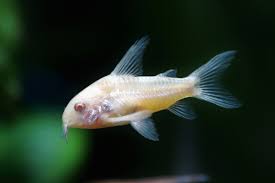
Albino Corydoras, also known as the Albino Cory Catfish, is a small, peaceful species of fish that is native to South America. They are a type of armored catfish and are known for their distinctive white and pink coloration, which is caused by a lack of pigmentation. They are a hardy species that is easy to care for, making them a popular choice for beginner fish keepers.
Albino Corydoras are relatively hardy fish, but they do require specific conditions to thrive. They prefer water temperatures between 72-78°F, with a pH level between 6.5-7.5. They also require a high-quality filtration system to keep the water clean and clear. They are best kept in a tank of at least 20 gallons, with plenty of hiding spots and plants.
Albino Corydoras are omnivorous fish that will eat a variety of different foods, including pellets, flakes, frozen, and live foods such as brine shrimp, worms, and small insects. They also enjoy eating vegetables such as peas, lettuce, and cucumber. It’s important to provide a balanced diet and to avoid overfeeding, as this can lead to health problems.
Albino Corydoras are known for their distinctive white and pink coloration, which is caused by a lack of pigmentation. They have a sleek, streamlined body shape and a distinctive pair of barbels on their face. They grow to be about 2-3 inches in length.
Albino Corydoras grow to be about 2-3 inches in length and can live for up to 10 years in captivity. They are relatively small and peaceful fish, which makes them a great addition to a community tank.
Albino Corydoras are known to be relatively peaceful and can be kept with other peaceful community fish. They are also known to be a great option for beginner fish keepers as they are relatively easy to care for and are hardy fish. They are a schooling fish and it is best to keep them in groups of at least 5 individuals to make them feel comfortable and thrive. They are also known to be a great option for those who are looking for a fish that is a little more unique and interesting to look at. They are also known to help keep the tank clean by eating algae and other debris.
Common Pleco (Hypostomus plecostomus)

The Common Pleco, also known as the Plecostomus or the Sucker Fish, is a species of catfish that is native to South America. They are known for their large size and their ability to keep tanks clean. They are a hardy species that is easy to care for, making them a popular choice for beginner fish keepers.
Common Plecos are relatively hardy fish, but they do require specific conditions to thrive. They prefer water temperatures between 72-78°F, with a pH level between 6.5-7.5. They also require a high-quality filtration system to keep the water clean and clear. They are best kept in a tank of at least 50 gallons, as they can grow up to 18 inches in length.
Common Plecos are opportunistic feeders and will eat a variety of different foods, including pellets, flakes, frozen, and live foods such as brine shrimp, worms, and small insects. They also enjoy eating vegetables such as peas, lettuce, and cucumber. It’s important to provide a balanced diet and to avoid overfeeding, as this can lead to health problems.
Common Plecos are known for their distinctive brown coloration and a large size. They have a sleek, streamlined body shape and a distinctive pair of barbels on their face. They grow to be about 18 inches in length.
Common Plecos grow to be about 18 inches in length and can live for up to 10 years in captivity. They are relatively large fish and will require a large tank. They are also known to be peaceful fish.
Common Plecos are known to be relatively peaceful and can be kept with other peaceful community fish. They are also known to be a great option for beginner fish keepers as they are relatively easy to care for and are hardy fish. They are also known to help keep the tank clean by eating algae and other debris. They are nocturnal fish, so they are active during the night and rest during the day. They are also known to be a great option for those who are looking for a fish that is a little more unique and interesting to look at. However, due to their size, they are not suitable for small tanks and it is important to keep them in a tank that is at least 50 gallons.
Otocinclus Catfish (Otocinclus spp.)
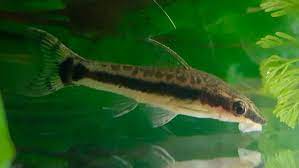
The Otocinclus Catfish, also known as the Oto Cat or the Dwarf Sucker, is a species of catfish that is native to South America. They are known for their small size and their ability to keep tanks clean. They are a hardy species that is easy to care for, making them a popular choice for beginner fish keepers and for those who want to keep a smaller, cleaner tank.
Otocinclus Catfish are relatively hardy fish, but they do require specific conditions to thrive. They prefer water temperatures between 72-78°F, with a pH level between 6.5-7.5. They also require a high-quality filtration system to keep the water clean and clear. They are best kept in a tank of at least 10 gallons, as they can grow up to 2 inches in length.
Otocinclus Catfish are opportunistic feeders and will eat a variety of different foods, including algae wafers, blanched vegetables, and live or frozen foods such as brine shrimp and bloodworms. They also enjoy eating algae that grows on the tank. It’s important to provide a balanced diet and to avoid overfeeding, as this can lead to health problems.
Otocinclus Catfish are known for their brownish coloration and a small size. They have a sleek, streamlined body shape and a pair of barbels on their face. They grow to be about 2 inches in length.
Otocinclus Catfish grow to be about 2 inches in length and can live for up to 5 years in captivity. They are relatively small fish and will require a small tank. They are also known to be peaceful fish.
Otocinclus Catfish are known to be relatively peaceful and can be kept with other peaceful community fish. They are also known to be a great option for beginner fish keepers as they are relatively easy to care for and are hardy fish. They are also known to help keep the tank clean by eating algae and other debris. They are nocturnal fish, so they are active during the night and rest during the day. They are also known to be a great option for those who are looking for a fish that is a little more unique and interesting to look at. However, due to their small size, they are not suitable for large tanks and it is important to keep them in a tank that is at least 10 gallons.
Red tail Shark (Epalzeorhynchos bicolor)

The Red tail Shark, also known as the Red tail Black Shark or the Red tail Sharkminnow, is a species of freshwater fish that is native to Southeast Asia. They are known for their striking coloration, which features a black body with a bright red tail. They are a hardy species that is relatively easy to care for, making them a popular choice for beginner fish keepers.
Red tail Sharks are relatively hardy fish, but they do require specific conditions to thrive. They prefer water temperatures between 72-78°F, with a pH level between 6.5-7.5. They also require a high-quality filtration system to keep the water clean and clear. They are best kept in a tank of at least 30 gallons, as they can grow up to 6 inches in length.
Red tail Sharks are opportunistic feeders and will eat a variety of different foods, including flakes, pellets, and live or frozen foods such as brine shrimp and bloodworms. They also enjoy eating algae that grows on the tank. It’s important to provide a balanced diet and to avoid overfeeding, as this can lead to health problems.
Red tail Sharks are known for their striking coloration, featuring a black body with a bright red tail. They have a sleek, streamlined body shape and can grow to be about 6 inches in length.
Red tail Sharks can grow to be about 6 inches in length and can live for up to 5-8 years in captivity. They are relatively large fish and will require a tank of at least 30 gallons. They are also known to be semi-aggressive fish.
Red tail Sharks are known to be semi-aggressive fish and should not be kept with other peaceful community fish. They are also known to be a great option for beginner fish keepers as they are relatively easy to care for and are hardy fish. However, due to their size, they are not suitable for small tanks and it is important to keep them in a tank that is at least 30 gallons. They are also known to be territorial and may become aggressive towards other fish that resemble their own species. It’s important to note that they should not be kept with other sharks and predatory fish. They are also known to be a great option for those who are looking for a fish that is a little more unique and interesting to look at.
Cherry Shrimp (Neocaridina davidi)
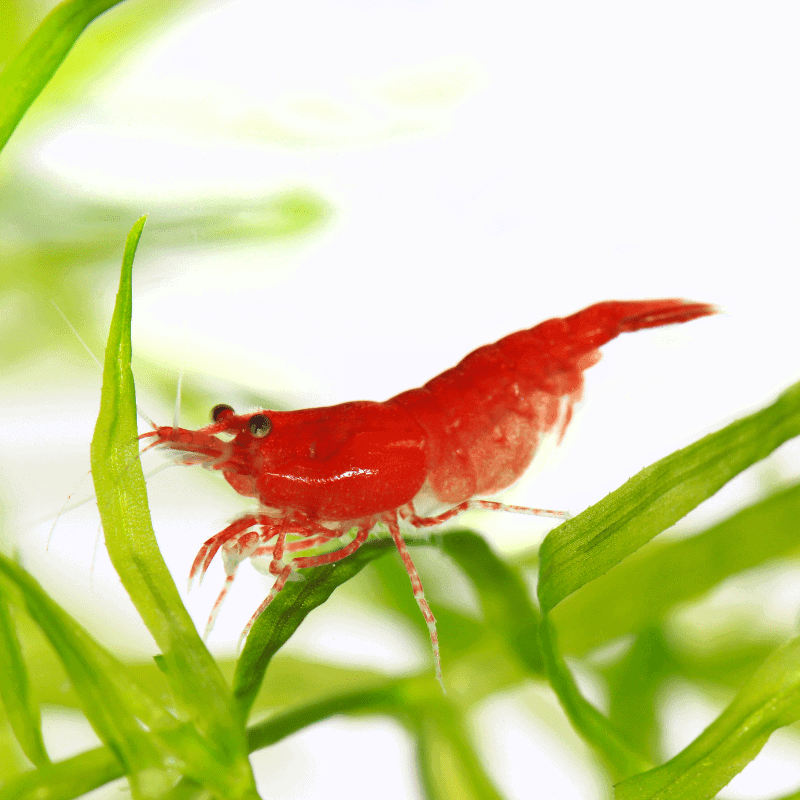
Cherry Shrimp, also known as Neocaridina Davidi, are a type of freshwater shrimp that are native to Taiwan. They are known for their vibrant red coloration, which gives them their name. They are a hardy species that is relatively easy to care for, making them a popular choice for beginner fish keepers and shrimp enthusiasts.
Cherry Shrimp are relatively hardy and adaptable, but they do require specific conditions to thrive. They prefer water temperatures between 60-78°F, with a pH level between 6.5-8. They also require a high-quality filtration system to keep the water clean and clear. They are best kept in a tank of at least 5 gallons, as they are small creatures and do not require a lot of space.
Cherry Shrimp are opportunistic feeders and will eat a variety of different foods, including algae, fish food, and plant material. They also appreciate being fed with algae wafers and blanched vegetables such as spinach and broccoli. It’s important to provide a balanced diet and to avoid overfeeding, as this can lead to health problems.
Cherry Shrimp are known for their vibrant red coloration, which gives them their name. They have a small body shape with a translucent exoskeleton and can grow to be about 1-2 inches in length.
Cherry Shrimp can grow to be about 1-2 inches in length and can live for up to 2 years in captivity. They are relatively small creatures and will require a tank of at least 5 gallons. They are also known to be peaceful creatures.
Cherry Shrimp are known to be peaceful creatures and make great addition to any community tank. They are also known to be a great option for beginner fish keepers as they are relatively easy to care for and are hardy creatures. However, due to their small size, they should not be kept with larger and aggressive fish. They are also known to be great cleaners and will help keep the tank clean by eating algae and other debris. They are also known to be a great option for those who are looking for a unique and interesting addition to their tank. They are also known to be great breeders and will reproduce quickly in a healthy tank.
Silver Dollar Fish (Metynnis argenteus)
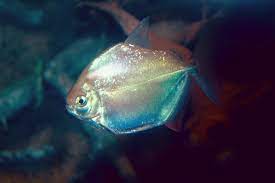
Silver Dollar Fish, also known as Metynnis argenteus, are a type of freshwater fish that are native to South America. They are known for their silver coloration, which gives them their name. They are a hardy species that is relatively easy to care for, making them a popular choice for beginner fish keepers and community tank enthusiasts.
Silver Dollar Fish are relatively hardy and adaptable, but they do require specific conditions to thrive. They prefer water temperatures between 72-82°F, with a pH level between 6-8. They also require a high-quality filtration system to keep the water clean and clear. They are best kept in a tank of at least 30 gallons, as they are large fish and require a lot of swimming space.
Silver Dollar Fish are opportunistic feeders and will eat a variety of different foods, including flakes, pellets, and live or frozen food. They also appreciate being fed with a variety of vegetable matter such as spinach, lettuce, or cucumber. It’s important to provide a balanced diet and to avoid overfeeding, as this can lead to health problems.
Silver Dollar Fish are known for their silver coloration, which gives them their name. They have a round body shape with a scaleless body and can grow to be about 6-8 inches in diameter.
Silver Dollar Fish can grow to be about 6-8 inches in diameter and can live for up to 10 years in captivity. They are relatively large fish and will require a tank of at least 30 gallons. They are also known to be peaceful creatures.
Silver Dollar Fish are known to be peaceful creatures and make great addition to any community tank. They are also known to be a great option for beginner fish keepers as they are relatively easy to care for and are hardy creatures. However, due to their large size, they should not be kept in tanks that are too small or with aggressive fish. They are also known to be great swimmers and will appreciate a lot of swimming space. They are also known to be great addition to a tank with plants, as they will not harm them. They are also known to be great for breeding and will reproduce quickly in a healthy tank.
Weather Loach (Misgurnus anguillicaudatus)
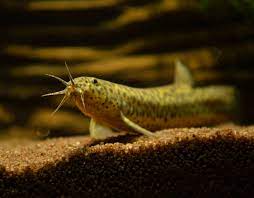
Weather Loach, also known as Misgurnus anguillicaudatus, is a freshwater fish native to East Asia. They are known for their long, slender body and eel-like appearance. They are hardy and adaptable, making them a popular choice for beginners and community tank enthusiasts. They are also known as “dojo loach” and “oriental weatherfish”.
Weather Loach are hardy and adaptable, but they do require specific conditions to thrive. They prefer water temperatures between 60-72°F, with a pH level between 6-7.5. They also require a high-quality filtration system to keep the water clean and clear. They are best kept in a tank of at least 30 gallons, as they are large fish and require a lot of swimming space. They also require a substrate of fine gravel or sand.
Weather Loach are opportunistic feeders and will eat a variety of different foods, including flakes, pellets, and live or frozen food. They also appreciate being fed with a variety of vegetable matter such as spinach, lettuce, or cucumber. They are also known to eat snails and other small invertebrates. It’s important to provide a balanced diet and to avoid overfeeding, as this can lead to health problems.
Weather Loach have a long, slender body and eel-like appearance. They have a brown or tan coloration with darker spots on their sides. They can grow to be about 6-10 inches in length.
Weather Loach can grow to be about 6-10 inches in length and can live for up to 10 years in captivity. They are relatively large fish and will require a tank of at least 30 gallons. They are also known to be peaceful creatures.
Weather Loach are known to be peaceful creatures and make great addition to any community tank. They are also known to be a great option for beginner fish keepers as they are relatively easy to care for and are hardy creatures. They are also known to be great swimmers and will appreciate a lot of swimming space. They are also known to be great addition to a tank with plants, as they will not harm them. They are also known to be great for breeding and will reproduce quickly in a healthy tank. They are also known to be great at controlling snail populations in the tank. However, they are known to be sensitive to water conditions and should be kept in a well-maintained tank.
Cardinal Tetras (Paracheirodon axelrodi)
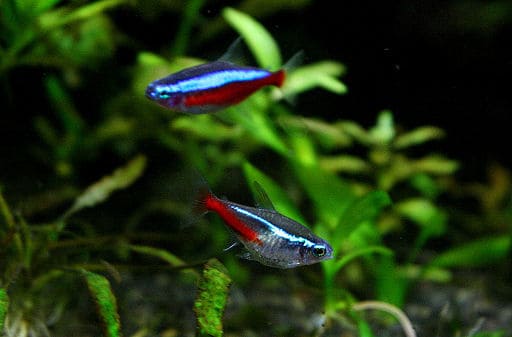
Cardinal Tetras, also known as Paracheirodon axelrodi, are a small freshwater fish native to the South American rivers, mainly in the Amazon basin. They are known for their bright red and neon blue coloration, making them a popular choice for planted tanks and community tanks. They are also known as “neon tetras” and “red neon tetras”.
Cardinal Tetras are hardy and adaptable, but they do require specific conditions to thrive. They prefer water temperatures between 72-82°F, with a pH level between 6-7.5. They also require a high-quality filtration system to keep the water clean and clear. They are best kept in a tank of at least 10 gallons, as they are small fish and require a lot of swimming space. They also require a substrate of fine gravel or sand.
Cardinal Tetras are opportunistic feeders and will eat a variety of different foods, including flakes, pellets, and live or frozen food. They also appreciate being fed with a variety of vegetable matter such as spinach, lettuce, or cucumber. They are also known to eat small invertebrates. It’s important to provide a balanced diet and to avoid overfeeding, as this can lead to health problems.
Cardinal Tetras have a small, slender body and a bright red and neon blue coloration. They can grow to be about 1.5 inches in length.
Cardinal Tetras can grow to be about 1.5 inches in length and can live for up to 5 years in captivity. They are relatively small fish and will require a tank of at least 10 gallons. They are also known to be peaceful creatures.
Cardinal Tetras are known to be peaceful creatures and make great addition to any community tank. They are also known to be a great option for beginner fish keepers as they are relatively easy to care for and are hardy creatures. They are also known to be great swimmers and will appreciate a lot of swimming space. They are also known to be great addition to a tank with plants, as they will not harm them. They are also known to be great for breeding and will reproduce quickly in a healthy tank. They are also known to be very sensitive to water conditions and should be kept in a well-maintained tank. They are also known to be very sensitive to changes in water conditions and should be acclimated carefully.
Hillstream Loach
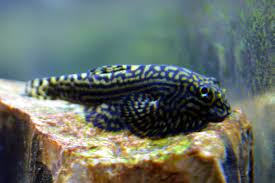
Hillstream Loach, also known as Butterfly Loach, is a unique and fascinating species of cold water fish that is native to fast-flowing streams and rivers in Asia. They have a distinctive, elongated body shape with a flattened underside that allows them to cling to rocks and other surfaces in the wild.
Hillstream Loaches have a distinct and striking appearance, with a long and slender body that can grow up to 6 inches in length. They have a light brown or gray coloration with dark brown or black spots and stripes that run along the length of their body. They have a flattened underside that helps them to cling to rocks and other surfaces.
Hillstream Loaches are relatively easy to care for and can thrive in a variety of water conditions. They prefer a pH range of 6.5-7.5 and a temperature range of 68-72 degrees Fahrenheit. They should be kept in a tank with a strong water flow, as they are accustomed to fast-flowing streams in the wild. They are also known to appreciate a cover of floating plants in their tank. They also need to be fed with high-quality sinking pellets, algae wafers and frozen or live foods.
Hillstream Loaches are primarily herbivorous and will thrive on a diet of high-quality sinking pellets, algae wafers, and frozen or live foods such as bloodworms, brine shrimp, and daphnia. They are also known to appreciate a good amount of vegetable matter in their diet such as blanched spinach, kale or zucchini.
Hillstream Loaches are peaceful fish that can be kept with a variety of other cold water species. They are known to be a little more shy compared to some other species, so it is best to provide plenty of hiding spots in the form of rocks, caves, and other decorations. They can be kept in a group of at least 6 individuals, in a tank that is at least 30 gallons or larger.
Hillstream Loaches can be kept with a variety of other cold water species such as tetras, rasboras, and danios. They should not be kept with larger or more aggressive species, as they may become stressed or bullied.
Overall, Hillstream Loaches are a unique and fascinating species of cold water fish that can make a great addition to any community tank. They are relatively easy to care for, but do require a tank with a strong water flow and a diet of high-quality sinking pellets, algae wafers and frozen or live foods. They are also known to appreciate a cover of floating plants in their tank and a group of at least 6 individuals.
Dojo Loach
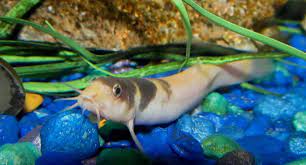
Dojo Loach, also known as the Weather Loach or Misgurnus anguillicaudatus, is a cold water fish that is native to East Asia. These fish have a long, eel-like body shape that is typically brown or gray in color, with a lighter belly and dark spots. Dojo Loaches can grow up to 12 inches in length, and they are known for their hardy nature and ability to adapt to a wide range of water conditions.
In the wild, Dojo Loaches are found in rivers, streams, and ponds, where they feed on a variety of aquatic invertebrates and small fish. In captivity, these fish can be fed a diet of high-quality flake or pellet food, as well as frozen or live foods such as worms and shrimp.
Dojo Loaches are peaceful fish that can be kept with other small to medium-sized species such as danios, tetras, and barbs. They are also great addition to a community tank as they are social and active fish that are great to observe. They are active swimmers and will enjoy a well-planted tank with plenty of hiding places.
Dojo Loaches are generally considered to be hardy fish that are easy to care for, making them a great choice for both experienced and novice aquarists. They are particularly well-suited to cold water tanks, and they can tolerate a wide range of water parameters. It’s important to note that these fish like to burrow and dig in the substrate, so it’s best to provide a soft substrate for them to do so.
In terms of tank size, a 20-gallon tank is the minimum recommended size for a single Dojo Loach, but a larger tank is preferable for a group of these fish. It’s important to also note that Dojo Loaches are sensitive to poor water conditions, so regular water changes and monitoring of water parameters is important for their health and well-being.
Overall, Dojo Loaches are a unique and interesting addition to any cold water tank and are a great option for those looking to add a hardy and adaptable fish to their aquarium. With proper care, these fish can live for several years in captivity and provide hours of enjoyment for their owners.
Endler’s Livebearer

Endler’s Livebearer, also known as Poecilia wingei, is a small, brightly colored fish that is native to Venezuela and Trinidad. They are a popular choice for cold water aquariums because of their vibrant colors and peaceful nature.
Endler’s Livebearers are small, typically reaching a maximum length of around 1.5 inches. They have a sleek, streamlined body shape and are typically a bright orange or red color with black spots. Some individuals may have a more yellow or green coloration.
Endler’s Livebearers are relatively hardy and easy to care for, making them a good option for beginners. They prefer a pH range of 6.5-7.5 and a water temperature between 72-78°F. They can be kept in a variety of tank sizes, but a minimum of 10 gallons is recommended. They are not demanding in terms of water quality, but regular water changes and filtration are important to maintain good health. They are also sensitive to high levels of nitrates and ammonia.
Endler’s Livebearers are not picky eaters and will accept a variety of foods, including flake food, pellets, frozen, and live food. Feeding them a variety of foods will help to maintain their coloration.
Endler’s Livebearers are peaceful, active fish that do well in a community tank. They can be kept with other small peaceful fish such as guppies, platies, and tetras. They are also compatible with small snails such as the nerite snail. They are known to be quite active and enjoy swimming around. They will also breed in captivity.
Endler’s Livebearers are a great addition to any cold water aquarium, due to their vibrant colors and peaceful nature. They are easy to care for and can be kept with a variety of other peaceful fish. They are a good option for both beginners and experienced aquarists.
Rainbow Shiner
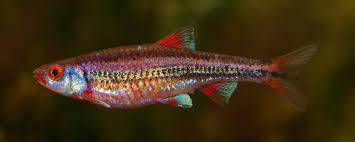
Rainbow Shiners, also known as Notropis chrosomus, are a species of freshwater fish that are native to the eastern United States. They are a small species that typically reach a maximum size of around 2 inches in length.
Rainbow Shiners are a hardy species that can adapt to a wide range of water conditions, making them a great choice for novice aquarists. They are also known for their beautiful coloration, which can range from silver to gold to iridescent blue, with red fins and a black band running down the lateral line.
Rainbow Shiners are a peaceful species and can be kept with a variety of other coldwater fish species. They are best kept in a group of at least 6 individuals, as they are a schooling fish and thrive in a group. They are also a great option for a community tank as they do well with other peaceful fish.
In terms of diet, Rainbow Shiners are not picky eaters and will consume a variety of foods such as flakes, pellets, frozen, and live food. They are also known to be opportunistic feeders and will eat algae and other plant matter.
When it comes to tank setup, Rainbow Shiners can be kept in a range of tank sizes, but a minimum of 10 gallons is recommended. They do well in tanks with plenty of hiding spots and vegetation, as well as a moderate current to mimic their natural habitat.
Overall, Rainbow Shiners are a beautiful and hardy species that make a great addition to any coldwater aquarium. With their peaceful nature and adaptability to a range of water conditions, they are a great option for both novice and experienced aquarists.
Clown Killifish
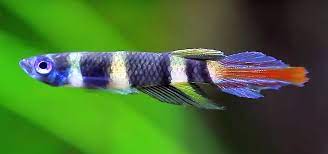
Clown Killifish, also known as Epiplatys annulatus, is a small species of freshwater fish that is native to West Africa. They are members of the Aplocheilidae family and are known for their unique coloration and patterning.
Clown Killifish are small fish, typically reaching a maximum size of around 1.5 inches. They have a distinctive appearance, with a silver body that is covered in orange and black spots. Their fins are also orange in color, and they have a distinct black band that runs through their eyes.
Clown Killifish are native to West Africa, specifically Ghana and the Ivory Coast. They are found in small streams and swamps, where the water is typically clear and acidic. In captivity, they can be kept in a freshwater aquarium, with a pH between 6.0 and 7.0, and a temperature range of 72-78°F. They prefer a heavily planted tank, with a sand or fine gravel substrate and a few hiding spots.
Clown Killifish are not picky eaters, and will accept a wide variety of foods in captivity. They can be fed a diet of small live foods, such as daphnia, brine shrimp, and bloodworms. They can also be fed frozen and freeze-dried foods, as well as flake and pellet foods.
Clown Killifish are peaceful fish that can be kept with other small, peaceful fish species. They are shoaling fish, and should be kept in groups of at least 6-8 individuals. They are also compatible with other small fish species, such as Neon Tetras, Guppies, and Endler’s Livebearers.
Clown Killifish are egg-laying fish and will lay their eggs in a fine-leaved plant or moss. The eggs are then fertilized by the male, and will hatch in around 7-10 days. The fry will be free-swimming and can be fed on small foods, such as microworms or crushed flakes.
Overall, Clown Killifish are a unique and beautiful species that can make a great addition to any community tank. They are easy to care for, peaceful, and can be kept with a variety of other fish species.
Celestial Pearl Danios
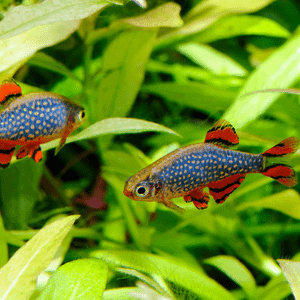
Celestial pearl danios, also known as Galaxy Rasboras or Galaxy Minnows, are small, colorful fish that are native to the fast-moving streams of Southeast Asia. These fish are known for their unique, shimmering scales that resemble pearls, hence the name “Celestial pearl.”
Appearance:
Celestial pearl danios are small fish, reaching an adult size of around 1 inch. They have a slender, elongated body shape with a dorsal fin that runs the entire length of the fish. Their scales have a unique, shimmering appearance that ranges in color from pale silver to bright metallic blue or green. They also have a distinctive dark spot on the base of their tail fin.
Celestial pearl danios prefer fast-moving water, so a tank with a strong filtration system and a powerhead for water flow is ideal. They also do well in planted tanks, as they are known to graze on algae. A tank of at least 10 gallons is recommended for a small group of these fish.
Celestial pearl danios are not picky eaters and will accept a variety of foods including flakes, pellets, and frozen or live foods. They also appreciate the occasional addition of fresh vegetables to their diet.
Celestial pearl danios are peaceful and active fish that are well-suited to community tanks. They are known to be schooling fish, so it is recommended to keep them in groups of 6 or more. They are also relatively hardy, making them a good choice for beginners.
Celestial pearl danios are compatible with a wide variety of other fish species, as long as they are peaceful and do not pose a threat to the small size of the danios. They can be kept with other small schooling fish such as tetras and rasboras, as well as with peaceful bottom-dwellers such as corydoras catfish.
Overall, Celestial pearl danios are a unique and colorful addition to any cold water aquarium. With their peaceful nature and hardiness, they are suitable for both experienced and novice aquarists alike.
Conclusion
Keeping cold water fish as pets can be a rewarding experience for both beginners and experienced aquarists alike. These hardy and adaptable fish can thrive in a wide range of water temperatures and can be kept in a variety of different tank setups. However, it’s important to do your research before setting up a cold water tank and to choose fish that are suitable for your specific setup.
In this comprehensive guide, we have discussed the basic equipment needed for setting up a cold water tank, the different types of cold water fish available, and their specific dietary needs. We have also covered the importance of maintaining proper water quality and temperature to ensure the health and well-being of your fish.
Remember that keeping cold water fish as pets requires patience, dedication, and a commitment to providing the best possible care for your fish. By following the guidelines outlined in this guide, you can ensure that your cold water fish thrive and provide you with years of enjoyment.
FAQs
What are the best cold water fish for beginners?
Goldfish, guppies, and betta fish are all great options for beginners. They are hardy, easy to care for, and come in a wide variety of colors and patterns.
What size tank do I need for cold water fish?
The size of the tank will depend on the number and size of the fish you plan to keep. A general rule of thumb is to provide at least 2-3 gallons of water per inch of fish.
Can cold water fish live with tropical fish?
No, cold water fish require a different range of water temperature and pH levels than tropical fish, so it’s best to keep them in separate tanks.
What temperature should the water be for cold water fish?
The ideal water temperature for most cold water fish is between 60-70°F.
What type of water is best for cold water fish?
Cold water fish prefer water that is neutral to slightly acidic, with a pH level between 7.0-7.5.
How often should I change the water in my cold water tank?
It’s recommended to do a partial water change of about 25% once a week.
What kind of filtration system do I need for a cold water tank?
A hang-on-back filter or canister filter is suitable for cold water tanks.
Can I keep cold water fish in a bowl?
No, cold water fish require a tank with a filter and heater to maintain proper water quality and temperature.
Can I keep more than one type of cold water fish in the same tank?
Yes, as long as the fish are compatible and the tank is large enough to accommodate them.
What do cold water fish eat?
Cold water fish are omnivorous and will eat a variety of different foods, such as live, frozen, and dried foods.
Do cold water fish need a heater?
Yes, cold water fish need a heater to maintain the proper water temperature.
Can I keep cold water fish in an outdoor pond?
Yes, cold water fish can be kept in an outdoor pond, as long as the temperature does not get too warm and the fish are protected from predators.
Can cold water fish get sick?
Yes, cold water fish can get sick if the water quality or temperature is not maintained properly.
How long do cold water fish live?
The lifespan of cold water fish can vary depending on the species, but most will live for several years.
Can cold water fish be trained to do tricks?
Some species of cold water fish, such as goldfish, can be trained to do simple tricks with the use of positive reinforcement.
Reference for Aquarium Topics
- The American Cichlid Association: https://www.cichlid.org/
- The North American Native Fishes Association: https://www.nanfa.org/
- The American Killifish Association: https://www.aka.org/
- The Livebearer Association: http://www.livebearers.org/
- The Catfish Study Group: http://www.catfishstudygroup.org/
- The British Killifish Association: https://www.bka.org.uk/
- The International Betta Congress: https://www.ibcbettas.org/
- The International Fancy Guppy Association: http://www.ifga.org/
- The International Livebearer Society: https://www.ils-livebearers.org/
- The International Pigeon Association: https://www.pigeon.org/
- The International Platy Association: https://www.platy.com/
- The International Swordtail Society: https://www.swordtail.org/
- The International Wild Bettabreeders Association: https://www.iwba.info/
- The International Wild Cichlid Association: https://www.iwc-cichlid.org/
- The Pterophyllum Society: https://www.angelfishsociety.com/
- The Rainbowfish Study Group: https://www.rainbowfish.org/
- The Society for the Study of Cichlidae: https://www.cichlidae.com/
- The World Guppy Association: https://www.wga.org/
- The World Killifish Association: https://www.worldkillifish.org/
- The World Livebearer Association: https://www.wla-livebearers.org/
Please also check out other articles on this blog Everything You Need to Know About Keeping Danio Fish as Pets – A Complete Guide, Tetra Fish: Everything You Need to Know About Keeping it
I am a passionate aquarist with over 30 years of hands-on experience in fishkeeping. My journey began at a young age, collecting fish from the wild and learning through experimentation. Specializing in tropical fish, I bring a deep understanding of the hobby to FishKeepingMadeSimple. The site provides honest, detailed reviews of essential products and accessories to help fellow enthusiasts create the best environments for their fish.

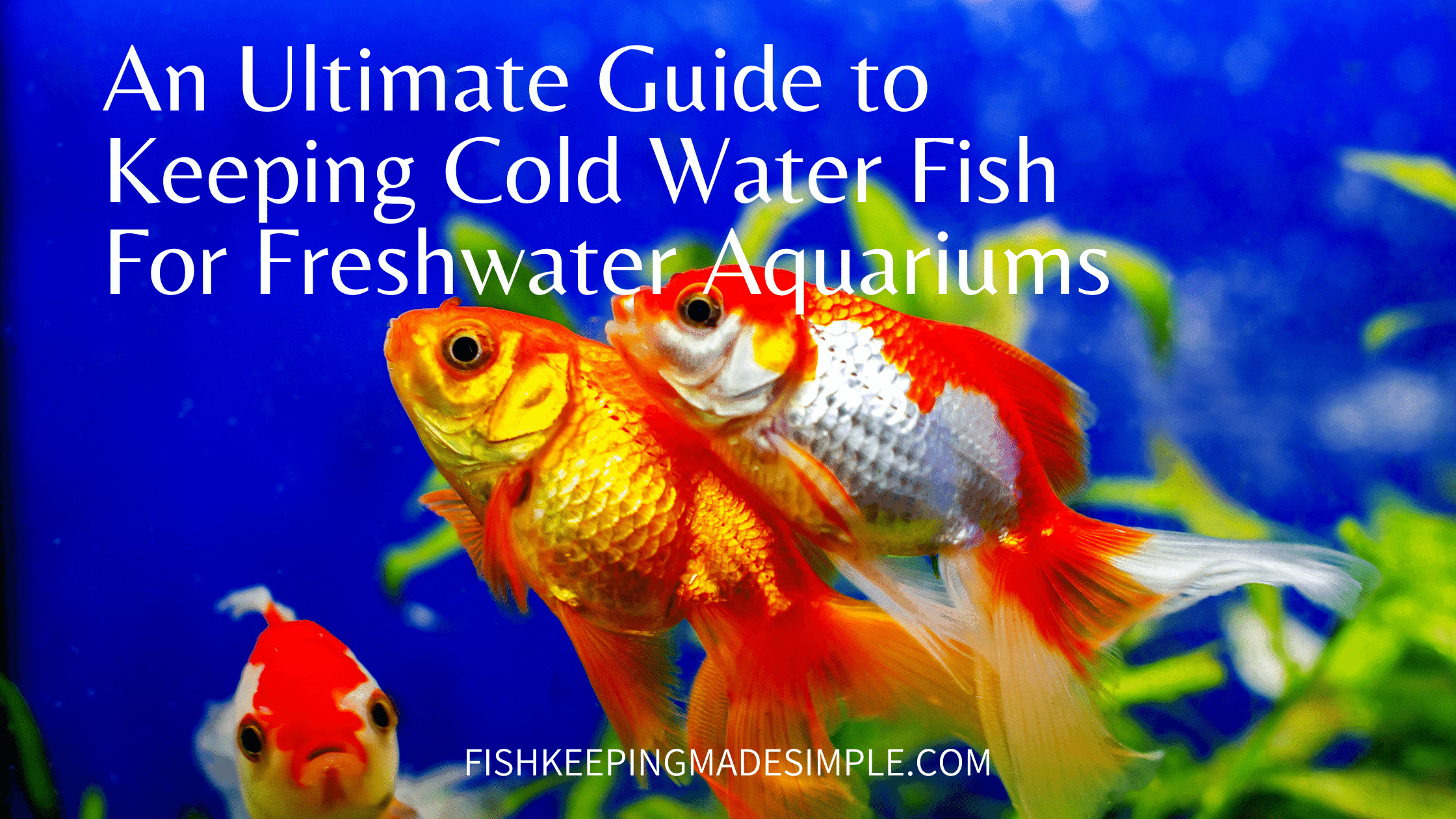








[…] food sticks are larger and denser than pellets or flakes. They sink slowly, allowing fish to feed at various water depths. These sticks are typically high in protein and provide a substantial meal for your koi […]
[…] well-maintained pond and optimal water conditions are paramount for the longevity of koi fish. Regular water testing, filtration system maintenance, and a balanced diet are key factors that […]
[…] water changes: Replace about 10-20% of the pond water every 1-2 weeks to remove accumulated toxins and […]
[…] of harmful substances and to maintain optimal water quality. Replace approximately 25% of the water every one to two weeks to keep the aquarium environment clean and […]
[…] necessary equipment: Set up a filter and heater to keep the water perfect for your fish. Adding places for fish to hide makes them feel […]
[…] Blue Phantom Pleco, a member of the pleco and catfish families, is an attractive armored suckermouth fish. It requires […]